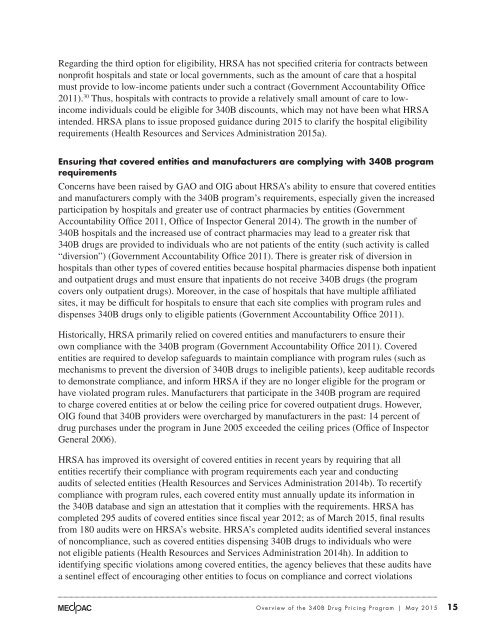Overview of the 340B Drug Pricing Program
1Mmfbin
1Mmfbin
You also want an ePaper? Increase the reach of your titles
YUMPU automatically turns print PDFs into web optimized ePapers that Google loves.
Regarding <strong>the</strong> third option for eligibility, HRSA has not specified criteria for contracts between<br />
nonpr<strong>of</strong>it hospitals and state or local governments, such as <strong>the</strong> amount <strong>of</strong> care that a hospital<br />
must provide to low-income patients under such a contract (Government Accountability Office<br />
2011). 30 Thus, hospitals with contracts to provide a relatively small amount <strong>of</strong> care to lowincome<br />
individuals could be eligible for <strong>340B</strong> discounts, which may not have been what HRSA<br />
intended. HRSA plans to issue proposed guidance during 2015 to clarify <strong>the</strong> hospital eligibility<br />
requirements (Health Resources and Services Administration 2015a).<br />
Ensuring that covered entities and manufacturers are complying with <strong>340B</strong> program<br />
requirements<br />
Concerns have been raised by GAO and OIG about HRSA’s ability to ensure that covered entities<br />
and manufacturers comply with <strong>the</strong> <strong>340B</strong> program’s requirements, especially given <strong>the</strong> increased<br />
participation by hospitals and greater use <strong>of</strong> contract pharmacies by entities (Government<br />
Accountability Office 2011, Office <strong>of</strong> Inspector General 2014). The growth in <strong>the</strong> number <strong>of</strong><br />
<strong>340B</strong> hospitals and <strong>the</strong> increased use <strong>of</strong> contract pharmacies may lead to a greater risk that<br />
<strong>340B</strong> drugs are provided to individuals who are not patients <strong>of</strong> <strong>the</strong> entity (such activity is called<br />
“diversion”) (Government Accountability Office 2011). There is greater risk <strong>of</strong> diversion in<br />
hospitals than o<strong>the</strong>r types <strong>of</strong> covered entities because hospital pharmacies dispense both inpatient<br />
and outpatient drugs and must ensure that inpatients do not receive <strong>340B</strong> drugs (<strong>the</strong> program<br />
covers only outpatient drugs). Moreover, in <strong>the</strong> case <strong>of</strong> hospitals that have multiple affiliated<br />
sites, it may be difficult for hospitals to ensure that each site complies with program rules and<br />
dispenses <strong>340B</strong> drugs only to eligible patients (Government Accountability Office 2011).<br />
Historically, HRSA primarily relied on covered entities and manufacturers to ensure <strong>the</strong>ir<br />
own compliance with <strong>the</strong> <strong>340B</strong> program (Government Accountability Office 2011). Covered<br />
entities are required to develop safeguards to maintain compliance with program rules (such as<br />
mechanisms to prevent <strong>the</strong> diversion <strong>of</strong> <strong>340B</strong> drugs to ineligible patients), keep auditable records<br />
to demonstrate compliance, and inform HRSA if <strong>the</strong>y are no longer eligible for <strong>the</strong> program or<br />
have violated program rules. Manufacturers that participate in <strong>the</strong> <strong>340B</strong> program are required<br />
to charge covered entities at or below <strong>the</strong> ceiling price for covered outpatient drugs. However,<br />
OIG found that <strong>340B</strong> providers were overcharged by manufacturers in <strong>the</strong> past: 14 percent <strong>of</strong><br />
drug purchases under <strong>the</strong> program in June 2005 exceeded <strong>the</strong> ceiling prices (Office <strong>of</strong> Inspector<br />
General 2006).<br />
HRSA has improved its oversight <strong>of</strong> covered entities in recent years by requiring that all<br />
entities recertify <strong>the</strong>ir compliance with program requirements each year and conducting<br />
audits <strong>of</strong> selected entities (Health Resources and Services Administration 2014b). To recertify<br />
compliance with program rules, each covered entity must annually update its information in<br />
<strong>the</strong> <strong>340B</strong> database and sign an attestation that it complies with <strong>the</strong> requirements. HRSA has<br />
completed 295 audits <strong>of</strong> covered entities since fiscal year 2012; as <strong>of</strong> March 2015, final results<br />
from 180 audits were on HRSA’s website. HRSA’s completed audits identified several instances<br />
<strong>of</strong> noncompliance, such as covered entities dispensing <strong>340B</strong> drugs to individuals who were<br />
not eligible patients (Health Resources and Services Administration 2014h). In addition to<br />
identifying specific violations among covered entities, <strong>the</strong> agency believes that <strong>the</strong>se audits have<br />
a sentinel effect <strong>of</strong> encouraging o<strong>the</strong>r entities to focus on compliance and correct violations<br />
<strong>Overview</strong> <strong>of</strong> <strong>the</strong> <strong>340B</strong> <strong>Drug</strong> <strong>Pricing</strong> <strong>Program</strong> | May 2015 15


